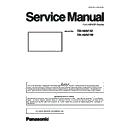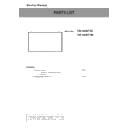Panasonic TH-49AF1U / TH-49AF1W (serv.man2) Service Manual ▷ View online
4
PREFACE
<49AF1>
4
TH-50LFC70U/TH-50LFC70W
1.3. Touch-Current Check (for TH-50LFC70W)
1. Plug the AC cord directly into the AC outlet. Do not use an isolation transformer for this check.
2. Connect a measuring network for touch currents between each exposed metallic part on the set and a good earth ground
2. Connect a measuring network for touch currents between each exposed metallic part on the set and a good earth ground
such as a water pipe, as shown in Figure 1.
3. Use Leakage Current Tester (Simpson 228 or equivalent) to measure the potential across the measuring network.
4. Check each exposed metallic part, and measure the voltage at each point.
5. Reserve the AC plug in the AC outlet and repeat each of the above measure.
6. The potential at any point (TOUCH CURRENT) expressed as voltage U
4. Check each exposed metallic part, and measure the voltage at each point.
5. Reserve the AC plug in the AC outlet and repeat each of the above measure.
6. The potential at any point (TOUCH CURRENT) expressed as voltage U
1
and U
2
, does not exceed the following values:
For a. c.: U
1
= 35 V (peak) and U
2
= 0.35 V (peak);
For d. c.: U
1
= 1.0 V,
Note:
The limit value of U
2
= 0.35 V (peak) for a. c. and U
1
= 1.0 V for d. c. correspond to the values 0.7 mA (peak) a. c. and 2.0
mA d. c.
The limit value U
The limit value U
1
= 35 V (peak) for a. c. correspond to the value 70 mA (peak) a. c. for frequencies greater than 100 kHz.
7. In case a measurement is out of the limits specified, there is a possibility of a shock hazard, and the equipment should be
repaired and rechecked before it is returned to the customer.
Figure 1
1.2. Touch current check (for TH-49AF1W)
5
PREFACE
<49AF1>
5
TH-50LFC70U/TH-50LFC70W
2 Warning
2.1. Prevention of Electrostatic Discharge (ESD) to Electrostatically Sensi-
tive (ES) Devices
Some semiconductor (solid state) devices can be damaged easily by static electricity. Such components commonly are called Elec-
trostatically Sensitive (ES) Devices. Examples of typical ES devices are integrated circuits and some field-effect transistors and
semiconductor “chip” components. The following techniques should be used to help reduce the incidence of component damage
caused by electrostatic discharge (ESD).
trostatically Sensitive (ES) Devices. Examples of typical ES devices are integrated circuits and some field-effect transistors and
semiconductor “chip” components. The following techniques should be used to help reduce the incidence of component damage
caused by electrostatic discharge (ESD).
1. Immediately before handling any semiconductor component or semiconductor-equipped assembly, drain off any ESD on your
body by touching a known earth ground. Alternatively, obtain and wear a commercially available discharging ESD wrist strap,
which should be removed for potential shock reasons prior to applying power to the unit under test.
which should be removed for potential shock reasons prior to applying power to the unit under test.
2. After removing an electrical assembly equipped with ES devices, place the assembly on a conductive surface such as alumi-
num foil, to prevent electrostatic charge buildup or exposure of the assembly.
3. Use only a grounded-tip soldering iron to solder or unsolder ES devices.
4. Use only an anti-static solder removal device. Some solder removal devices not classified as “anti-static (ESD protected)” can
4. Use only an anti-static solder removal device. Some solder removal devices not classified as “anti-static (ESD protected)” can
generate electrical charge sufficient to damage ES devices.
5. Do not use freon-propelled chemicals. These can generate electrical charges sufficient to damage ES devices.
6. Do not remove a replacement ES device from its protective package until immediately before you are ready to install it. (Most
6. Do not remove a replacement ES device from its protective package until immediately before you are ready to install it. (Most
replacement ES devices are packaged with leads electrically shorted together by conductive foam, aluminum foil or compara-
ble conductive material).
ble conductive material).
7. Immediately before removing the protective material from the leads of a replacement ES device, touch the protective material
to the chassis or circuit assembly into which the device will be installed.
Caution
Be sure no power is applied to the chassis or circuit, and observe all other safety precautions.
8. Minimize bodily motions when handling unpackaged replacement ES devices. (Otherwise ham less motion such as the brush-
ing together of your clothes fabric or the lifting of your foot from a carpeted floor can generate static electricity (ESD) sufficient
to damage an ES device).
to damage an ES device).
2. Warning
2.1. Prevention of Electrostatic Discharge (ESD) to Electrostatically Sensitive
(ES) Devices
(ES) Devices
6
PREFACE
<49AF1>
6
TH-50LFC70U/TH-50LFC70W
2.2. About lead free solder (PbF)
Note: Lead is listed as (Pb) in the periodic table of elements.
In the information below, Pb will refer to Lead solder, and PbF will refer to Lead Free Solder.
The Lead Free Solder used in our manufacturing process and discussed below is (Sn+Ag+Cu).
That is Tin (Sn), Silver (Ag) and Copper (Cu) although other types are available.
This model uses Pb Free solder in it’s manufacture due to environmental conservation issues. For service and repair work, we’d
suggest the use of Pb free solder as well, although Pb solder may be used.
suggest the use of Pb free solder as well, although Pb solder may be used.
Caution
• Pb free solder has a higher melting point than standard solder. Typically the melting point is 50 ~ 70 °F (30~40 °C) higher. Please
use a high temperature soldering iron and set it to 700 ± 20 °F (370 ± 10 °C).
• Pb free solder will tend to splash when heated too high (about 1100 °F or 600 °C).
If you must use Pb solder, please completely remove all of the Pb free solder on the pins or solder area before applying Pb sol-
der. If this is not practical, be sure to heat the Pb free solder until it melts, before applying Pb solder.
der. If this is not practical, be sure to heat the Pb free solder until it melts, before applying Pb solder.
• After applying PbF solder to double layered boards, please check the component side for excess solder which may flow onto the
opposite side. (see figure below)
Suggested Pb free solder
There are several kinds of Pb free solder available for purchase. This product uses Sn+Ag+Cu (tin, silver, copper) solder. How-
ever, Sn+Cu (tin, copper), Sn+Zn+Bi (tin, zinc, bismuth) solder can also be used.
ever, Sn+Cu (tin, copper), Sn+Zn+Bi (tin, zinc, bismuth) solder can also be used.
2.2. About lead free solder (PbF)
7
PREFACE
<49AF1>
3. Specifications
113
English
Specifications
Model No.
55-inch model
: TH-55AF1U
49-inch model
: TH-49AF1U
42-inch model
: TH-42AF1U
55-inch model
: TH-55AF1W
49-inch model
: TH-49AF1W
42-inch model
: TH-42AF1W
Power Consumption
55-inch model
190 W
49-inch model
175 W
42-inch model
155 W
Power off condition
0.3 W
Stand-by condition
(when [OpenPort PLATFORM standby] is set to [Off])
(when [OpenPort PLATFORM standby] is set to [Off])
0.5 W
Stand-by condition
(when [OpenPort PLATFORM standby] is set to [On]
(when [OpenPort PLATFORM standby] is set to [On]
(Factory default))
approx. 20 W
LCD Display panel
55-inch model
55-inch IPS panel (Edge LED backlight), 16:9 aspect
ratio
49-inch model
49-inch IPS panel (Edge LED backlight), 16:9 aspect
ratio
42-inch model
42-inch IPS panel (Edge LED backlight), 16:9 aspect
ratio
Screen size
55-inch model
1 209 mm (W) × 680 mm (H) × 1 387 mm (diagonal) /
47.6” (W) × 26.7” (H) × 54.6” (diagonal)
49-inch model
1 073 mm (W) × 604 mm (H) × 1 232 mm (diagonal) /
42.2” (W) × 23.7” (H) × 48.5” (diagonal)
42-inch model
927 mm (W) × 521 mm (H) × 1 064 mm (diagonal) /
36.5” (W) × 20.5” (H) × 41.9” (diagonal)
Number of pixels
2 073 600 (1 920 (W) × 1 080 (H))
Dimensions (W × H × D)
55-inch model
1 229 mm × 699 mm × 72 mm (57 mm: without
handles) /
48.4” × 27.6” × 2.8” (2.3”: without handles)
49-inch model
1 093 mm × 623 mm × 72 mm (57 mm: without
handles) /
43.1” × 24.6” × 2.8” (2.3”: without handles)
42-inch model
947 mm × 541 mm × 72 mm (57 mm: without
handles) /
37.3” × 21.3” × 2.8” (2.3”: without handles)
Mass
55-inch model
approx. 25.0 / 55.2 lbs net
49-inch model
approx. 19.3 / 42.6 lbs net
42-inch model
approx. 15.6 / 34.4 lbs net
Power source
TH-55AF1U, TH-49AF1U, TH-42AF1U:
110 - 127V (110-127V alternating current), 50/60Hz
TH-55AF1W, TH-49AF1W, TH-42AF1W:
220 - 240V (220-240V alternating current),
50/60Hz
Operating condition
Temperature
0 °C to 40 °C (32 °F to 104 °F)*
1
Humidity
20 % to 80 % (no condensation)
Storing condition
Temperature
-20 °C to 60 °C (-4 °F to 140 °F)
Humidity
20 % to 80 % (no condensation)
OpenPort PLATFORM system
OS
Android 4.4.3
CPU
Cortex-A9, 1.0 GHz (quad)
Memory
RAM 1 GB / ROM 8 GB


